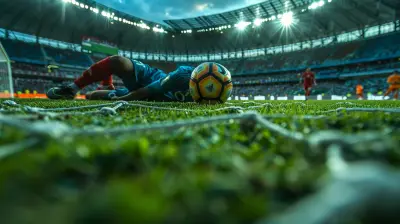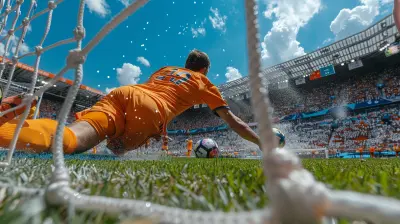21 January 2025
In sports, there's a fine line between defense and attack, like the flip of a switch that can change the course of a game in an instant. Whether you're playing soccer, basketball, or rugby, transitioning from defense to attack is one of the most critical aspects of gameplay. It’s not just about getting the ball back—oh no, it's about seizing the moment and turning defense into a powerful offensive strategy. But how do you master this art?
In this article, we’re going to dive deep into the tactics, mindset, and skills needed to perfect that transition from defense to attack. Whether you’re an athlete, coach, or just a fan wanting to better understand the nuances of the game, this guide will break it all down for you. So, let’s get started, shall we?

Why is Transition Important?
Transitioning from defense to attack is like flipping a light switch. One moment you’re under pressure, scrambling to protect your goal or basket, and the next, you're on the front foot, looking for ways to exploit the opposition's weaknesses. This shift is vital for two main reasons:1. Momentum Shift: A successful transition can completely shift the momentum of a game. Your opponent, focused on attacking, may not be prepared for a quick counterattack. This is your chance to catch them off guard and capitalize.
2. Psychological Impact: A swift transition can demoralize your opponents. They go from being on the verge of scoring to suddenly facing a counterattack. It’s a mental game as much as it is a physical one.
Now that we know why it’s important, let’s break down how you can master this all-important phase of the game.

The Key Elements of a Successful Transition
To excel in transitioning from defense to attack, you need to focus on several key elements. These elements are widely applicable across various sports, from soccer and basketball to rugby and hockey. Let's break them down:1. Anticipation and Awareness
The first step in mastering transition is understanding the game's flow. You need to anticipate when your team will regain possession. This requires:- Scanning the field: Always keep your head up and be aware of where your teammates and opponents are positioned. This is vital for both defenders and attackers.
- Reading the game: Anticipate your opponent's next move. Are they about to make a risky pass? Are they overcommitting too many players forward? Recognizing these moments can give you the upper hand.
- Quick decision-making: Once you regain possession, you need to make fast, smart decisions. Do you pass, dribble, or shoot? Hesitation can kill a counterattack.
2. Speed and Precision
In the transition phase, speed is everything. You need to act fast and decisively. But it’s not just speed for the sake of it—it’s speed with precision:- Quick passing: One-touch passes and quick ball movement are essential. The faster the ball moves, the less time the opposition has to reorganize their defense.
- Explosive runs: Players need to burst into open spaces, exploit gaps in the opponent’s formation, and stretch their defensive line. Timing is crucial here—make your move too early, and you’ll be caught offside or marked out of the game.
- Controlled aggression: Yes, you need to be fast, but you also need to stay in control. Overcommitting or rushing without thought can lead to sloppy play and turnovers.
3. Positional Play and Structure
While speed is critical, you also need a solid structure. Transitioning doesn’t mean sending everyone forward in a chaotic scramble. A well-organized team knows how to maintain its shape, even in attack:- Support play: When transitioning, players should provide multiple passing options. This means being in the right positions to support the player on the ball. It’s about creating triangles, where the player with the ball always has at least two passing options.
- Spacing: Proper spacing prevents your team from getting too crowded in one area, making it easier to exploit gaps in the opposition's defense.
- Balance: It’s tempting to throw everyone forward, but you need a balance. Keep some players back to protect against a potential counterattack. Think of it as a safety net—if your attack breaks down, you’re not left completely exposed.
4. Communication and Coordination
No matter how talented individual players are, transitioning from defense to attack requires communication and coordination. It’s a team effort:- Verbal cues: Players should be constantly talking to one another—calling for the ball, warning of incoming pressure, or signaling a gap in the opposition’s defense.
- Non-verbal communication: Sometimes, a simple gesture or a look is enough to signal a run or pass. Good teams develop this kind of silent communication over time. It’s about building chemistry.
- Trust: To transition effectively, players need to trust each other. A defender must trust that if they send a long ball forward, someone will be there to receive it. Similarly, attackers need to trust that their teammates will cover for them if the ball is lost.
5. Mental Toughness and Adaptability
Transitioning from defense to attack isn’t just a physical challenge—it’s a mental one. You need the mental toughness to switch gears instantly:- Stay composed under pressure: When you win the ball back, you often do so in high-pressure situations. The best players stay calm and composed, even when the heat is on.
- Adaptability: No two transitions are the same. Sometimes you’ll need to launch a quick counter, while other times, you'll need to slow down and build from the back. Being able to read the situation and adapt accordingly is key.

Sport-Specific Transition Tactics
While the above elements apply broadly to most sports, different sports have their own unique tactics for transitioning from defense to attack. Let’s take a look at some specific examples:Soccer: The Counterattack
In soccer, the counterattack is one of the most effective ways to transition from defense to attack. It often involves:- Winning the ball deep in your own half: This typically happens when you intercept a pass or win a tackle.
- Quick outlet pass: The moment you regain possession, you need to find an outlet—usually a midfielder or winger—who can carry the ball forward.
- Fast break: Once the ball is out of your defensive third, players sprint forward into attacking positions. Wingers push wide, strikers make diagonal runs, and midfielders support from behind.
The key in soccer is to move the ball quickly up the field before the opposition has time to reset their defense.
Basketball: Fast Break
In basketball, the equivalent of the counterattack is the fast break. It’s all about turning a defensive rebound or steal into a scoring opportunity:- Rebound or steal: Once you secure the ball, the transition starts immediately.
- Outlet pass: The ball is quickly passed to a guard or forward who is already sprinting up the court.
- Numbers advantage: The goal is to create a situation where you have more offensive players than the defense has back, allowing for an easy layup or open jump shot.
In basketball, speed is even more critical because the court is smaller, and defenders can recover more quickly.
Rugby: Turnover Ball
In rugby, turnovers are golden opportunities to transition from defense to attack. When you win the ball back:- Quick recycling: The ball needs to be passed out of the breakdown area as quickly as possible to your backs, who can exploit the fragmented defense.
- Overlap creation: It’s common to have a numbers advantage after a turnover, especially if the opposition has committed too many players to the ruck. Use this to create overlaps and outnumber the defense.
- Kicking for territory: Sometimes, the best transition isn’t to run the ball but to kick it into open space and apply pressure.












Xavi Whitaker
Great insights on transitioning from defense to attack! Your analysis of key strategies and player positioning really highlights the importance of adaptability in sports. Looking forward to implementing these techniques in our upcoming matches. Keep up the excellent work!
February 2, 2025 at 12:39 PM